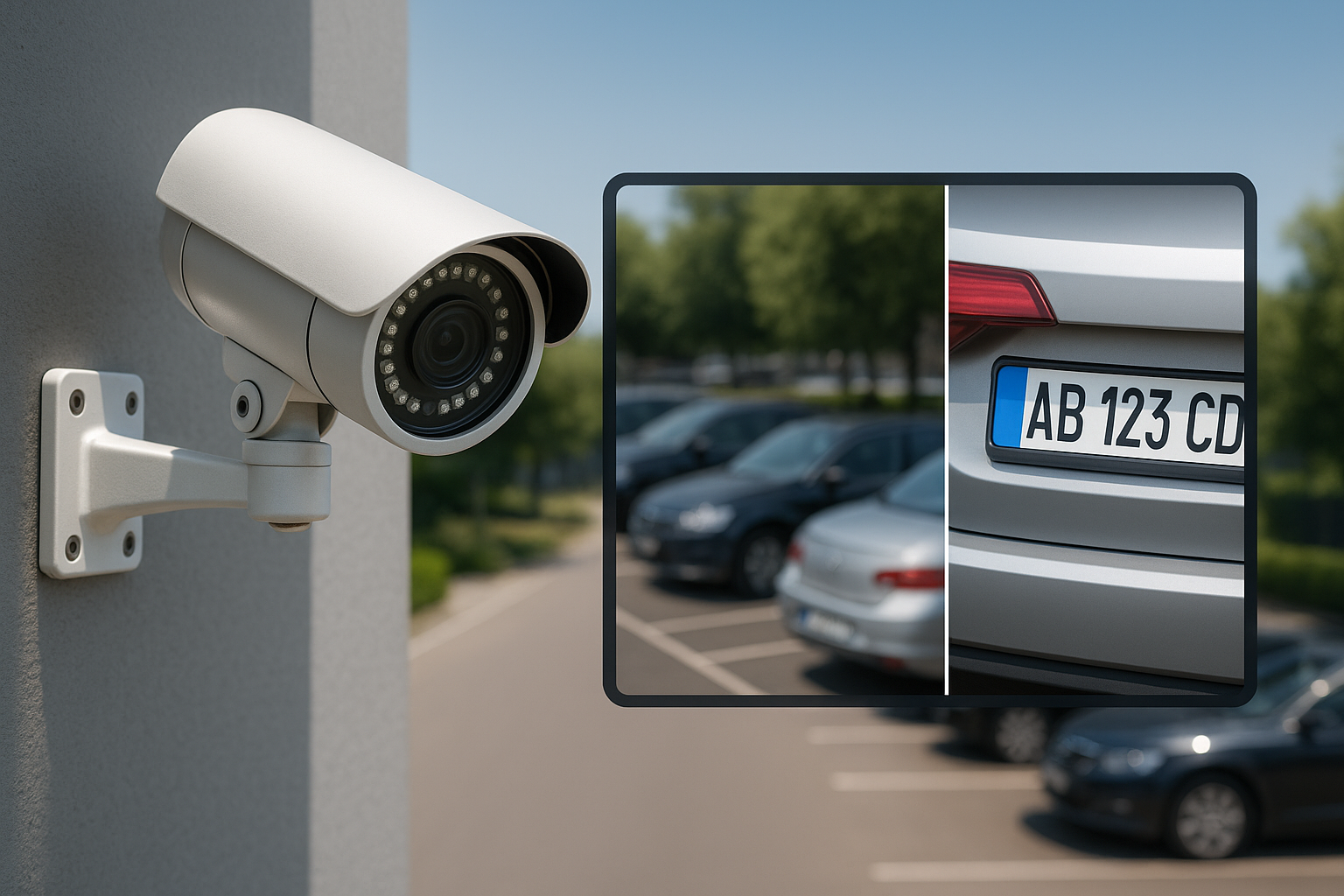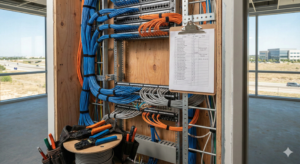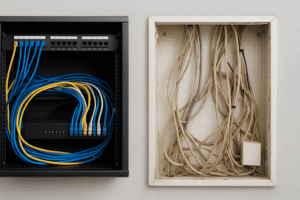Let’s imagine there comes a day where you are squinting at blurry footage trying to figure out if that’s a delivery boy or a thief on your property? That’s exactly where a zoomable security camera changes the game, being an impressive gift of modern technology. These cameras allow you to zoom in and out on subjects without physically moving the camera. This means more coverage, clearer images, and better security, whether you’re monitoring a small office entrance or a large warehouse parking lot.
By allowing operators to see objects in close detail or in a wide view, zoom functions give you more control and clarity. By using your fingers or a button on the video receiver, you can zoom in or out of the monitoring image. Whether you need to identify a license plate or observe the full perimeter of a property, the zoomable security camera has your back.
1. Optical Zoom vs. Digital Zoom: What’s the Real Difference?
Optical Zoom:
Optical zoom is a camera feature that uses the physical movement of lens elements to magnify an image, similar to how telescopes work. This type of zoom maintains the original image resolution and clarity, as it adjusts the focal length to bring objects closer without any digital manipulation. Optical zoom features consistent image quality across zoom levels, the ability to focus on distant objects with precision, and is suitable for detailed surveillance tasks like identifying faces or reading license plates.
Digital Zoom:
Digital zoom, on the other hand, is a software-based function that enlarges the image by cropping and digitally magnifying the central portion of a frame. Unlike optical zoom, it does not involve moving lens elements or changing the focal length. While digital zoom can make subjects appear closer, it often results in blurriness, especially at higher zoom levels. It is simply used for tasks that do not require high-resolution detail.
Comparison and Contrast:
The underlying question is: which one zooms better and smarter? While both optical and digital zoom serve the purpose of magnifying an image, their methods and outcomes differ significantly. It is like the approaches to the end goal are different. Optical zoom provides true magnification through mechanical lens adjustments, ensuring that image quality remains intact, even at high zoom levels. It is ideal for professional surveillance. Digital zoom, in contrast, simply enlarges existing pixels, ultimately leading to potential distortion and blurring. Though digital zoom can be useful in small-scale monitoring.
Note: If your goal is forensic-level detail, an optical zoom surveillance camera is a better choice. It zooms in successfully without sacrificing quality. However, it is a bit more expensive than digital zoom.
2. How Zoomable Cameras Actually Work
Zoomable cameras are equipped with adjustable lenses that can change the focal length. These lenses shift elements within to change focus from wide-angle to telephoto security camera settings. The result is flexible depth-of-field control and better image composition.
The trick lies in engineering: when the lens elements move farther apart, distant objects are brought closer. Move them closer together, and the lens captures a wider view. This isn’t just a zoom—it works like an optical magic designed to make surveillance more dynamic and accurate, and the results more reliable.
3. Core Benefits of Using Zoomable Cameras
The first major win? Unmatched clarity. A high zoom security camera doesn’t just bring objects closer—it captures fine details like facial features, license plates, or name tags without losing resolution. You can mount the camera higher or farther from the target zone without compromising image quality.
Second, you get tactical versatility. A camera with zoom capabilities smoothly shifts from a wide-angle overview to very sharp close-ups. You can monitor a parking lot one moment and zoom in on a suspicious vehicle the next, without much hassle.
And let’s not forget the preventive side of it, because perception matters. The presence of a visibly telephoto or PTZ camera instantly stops a thief before he commits a theft, thus elevating the perceived level of surveillance. Intruders don’t just think twice—they often change their minds and walk away. They will most likely take their business elsewhere.
4. Top Features to Look for in Zoomable Security Cameras
Not all zoomable security cameras are created equal. Look for features like:
- PTZ capabilities (Pan-Tilt-Zoom) for total directional control
- Night vision with infrared sensors for low-light monitoring
- Auto-tracking to follow subjects as they move
- Weather resistance for outdoor use
- High-resolution sensors to support zoom without losing detail
Note: If you’re investing in a high zoom security camera, make sure it supports remote zoom adjustment, so you can control the lens from your phone or desktop.
5. PTZ vs. Fixed Zoom: Which One Fits You?
PTZ (Pan-Tilt-Zoom) Cameras:
Surveillance is not supposed to be just static, it can be movable and flexible. PTZ cameras are built for flexibility and command. With the ability to pan left and right, tilt up and down, and zoom in on details—all remotely—you can actively track movement across vast spaces in real time. These cameras are perfect for dynamic environments like parking lots, shopping centers, or large industrial yards, where threats may appear in different locations and directions.
Fixed Zoom Cameras:
Fixed zoom security cameras are designed to stay locked on one critical area. While they don’t move or track motion, they have their own unique points to show. For example, they often offer superior optical zoom quality and sharper long-range focus due to their stable, single-angle setup. Ideal for monitoring high-security spots like entry gates and reception areas where continuous visual clarity on one location is a priority.
Which Should to Choose?
If your security needs involve active monitoring over a large, ever-changing space, PTZ cameras are the way to go—they are like two alert eyes following wherever any action happens. On the other hand, if your focus is on capturing forensic-level detail in a specific zone, a fixed zoom camera delivers better clarity and results. Ultimately, it’s not about which one is better—it’s about what fits your surveillance needs best: flexibility or fixed focus.
6. Zoomable Cameras for Businesses
One smart zoom is better than many static lenses. That is true especially for businesses where zoomable cameras can help reduce the need for multiple fixed cameras. You can install one optical zoom surveillance camera high on a corner to monitor a large retail floor, zooming in only when needed. And that will save you the trouble and budget of installing many cameras in different areas.
Businesses also benefit from footage clarity during incidents. Whether it’s a customer dispute or a break-in, zoomed footage gives more actionable evidence, which helps in both legal and insurance processes.
7. Residential Use: Why You Might Need Zoom Too
It’s not just businesses—homeowners can benefit greatly from zoomable security cameras as well. Whether you’re keeping an eye on your front porch, tracking unfamiliar activity at the end of your driveway, or zooming in on movement near your fence line or gate, the added range and clarity make a huge difference. Zoom functionality allows you to capture clearer facial features or license plate numbers, crucial when dealing with theft, vandalism, or suspicious visitors.
Plus, many modern systems integrate with mobile apps, letting you control zoom, tilt, and focus in real time from anywhere. Whether you’re at work or somewhere in another city, you can monitor your property with precision. For parents, it even doubles as a safety tool, keeping an eye on kids playing outside or visitors approaching the house. In short, zoomable cameras offer not just surveillance, but smarter, more proactive protection.
8. Why Telephoto Security Cameras Are a Big Deal
Telephoto security cameras are a game-changer for properties where close-range installation isn’t possible, or let’s say, practical. Whether it’s monitoring a front gate from a tall commercial building, overseeing a large parking lot, or watching a property boundary from a farmhouse porch, these cameras allow you to keep a close eye on distant areas without physically moving the camera closer. And it is thanks to their long focal length lenses, telephoto cameras can zoom in on faraway subjects while maintaining sharpness and detail, crucial when trying to identify a face, license plate, or suspicious object from a distance.
Unlike digital zoom which compromises on quality, these cameras rely on optical zoom to preserve clarity even at full magnification. They’re ideal for farms, large estates, construction sites, and industrial perimeters. Plus, when paired with smart video analytics, telephoto cameras can detect motion or unusual behavior across vast areas, turning them into effective vantage points.
9. Camera Installation: What Professionals Do Differently
Installing a zoomable security camera goes far beyond simply mounting it on a wall. Proper installation turns a good-performing camera into a great-performing camera. Professionals take a strategic approach, analyzing angles, lighting conditions, elevation, and the optimal zoom range to ensure the camera captures exactly what it needs to. They study the environment to eliminate blind spots and avoid glare or too much lighting that could affect visibility. A key part of expert installation is adjusting the camera’s back-focus, which ensures that zoomed-in images remain focused at all times. Proper cabling, weatherproofing, and positioning also help extend the camera’s life and improve performance.
10. Pro Tips for Zoom Camera Setup
- Avoid glare by avoiding direct sunlight
- Mount on stable surfaces to prevent vibrations during zoom
- Use a junction box to protect cables and connections
- Connect to a DVR/NVR that supports high-resolution zoom footage
- Secure remote access so you can adjust zoom when needed
11. Indoor vs. Outdoor Zoom Cameras
Outdoor zoomable security cameras should have weatherproof housings (IP66 or higher). They also need better night vision and wider dynamic range for outdoor light conditions. These features help the camera handle unpredictable weather, direct sunlight, and nighttime surveillance without losing image quality.
Indoor versions focus on clarity, low-light sensitivity, and compact design to blend into interiors. They’re often installed in offices, hallways, or living rooms, where aesthetics matter as much as performance. They also have smart features like motion tracking, two-way audio, and integration with home automation systems.
12. Key Statistics
The FBI’s crime statistics show that national violent crime decreased an estimated 1.7% in 2022 compared to 2021 estimates. Surveillance footage helped solve more than 60% of those cases.
One report revealed that vehicle crime was reduced by 75 per cent (12 to 3 offences) in the six months after the cameras were installed, and this decrease accounted for the reduction in total crime.
13. Upgrading Your System with Zoom Tech
Do you already have cameras? You might not need to replace your whole system. Some DVR/NVR systems support add-ons. You can start by installing a telephoto security camera in a vulnerable spot.
Many modern security brands offer modular integration, making upgrades smooth and easy. Just make sure your system supports the resolution and data rate needed for high-zoom footage.
14. How Zoom Helps with Evidence Collection
Imagine this: There’s a break-in at your property. Thanks to your optical zoom surveillance camera, the intruder’s face is captured in crystal-clear detail. But it doesn’t stop there. The camera zooms in smoothly to reveal the license plate of their getaway car parked across the street. That’s not just surveillance—it’s solid evidence for a police station or a court.
Zoom doesn’t just help you see more; it also helps you prove more. Whether it’s identifying a suspect, tracking movement, or catching critical details like tattoos, clothing, or vehicle make, zoom adds depth and credibility to your footage. In legal investigations, clear detail means power, and zoom delivers it.
15. Cloud Integration: Zoom from Anywhere
Most advanced zoomable security cameras now integrate with cloud platforms. This allows for real-time monitoring and control from anywhere in the world. You can log in to your mobile app, rewind footage, and even adjust settings—all remotely.
16. Data Security and Privacy in Zoom Surveillance
As they say, with greater power comes greater responsibility. Zoom cameras capture a lot, and that includes private spaces if not aimed correctly. Ensure you’re compliant with local surveillance laws. Steer away the cameras from private areas digitally, and encrypt your footage if stored in the cloud. Responsible usage builds trust.
17. Top Brands to Explore
Some well-reviewed brands in the high zoom security camera category include:
18. Common Mistakes to Avoid
- Overusing digital zoom—stick to optical for clarity
- Improper mounting—causes shaky images
- Neglecting lens maintenance—dirty lenses distort zoom quality
- Incompatible NVR—can’t handle high-res feeds
- Skipping testing—always check angles and zoom paths
19. Final Thoughts: Invest in Clarity
Security isn’t just about finding out who committed the theft or transgression, it is also about preventing all of it in the first place. So it is preventing by watching. A zoomable security camera turns your surveillance system from a passive observer to an active preventer.
Whether you run a business or just want peace of mind at home, zoom cameras—especially optical zoom surveillance cameras—offer the detail, control, and deterrence that traditional cameras simply can’t do. They let you focus in on the moments that matter, and capture critical evidence. In short, they are the true guardians of modern security.





